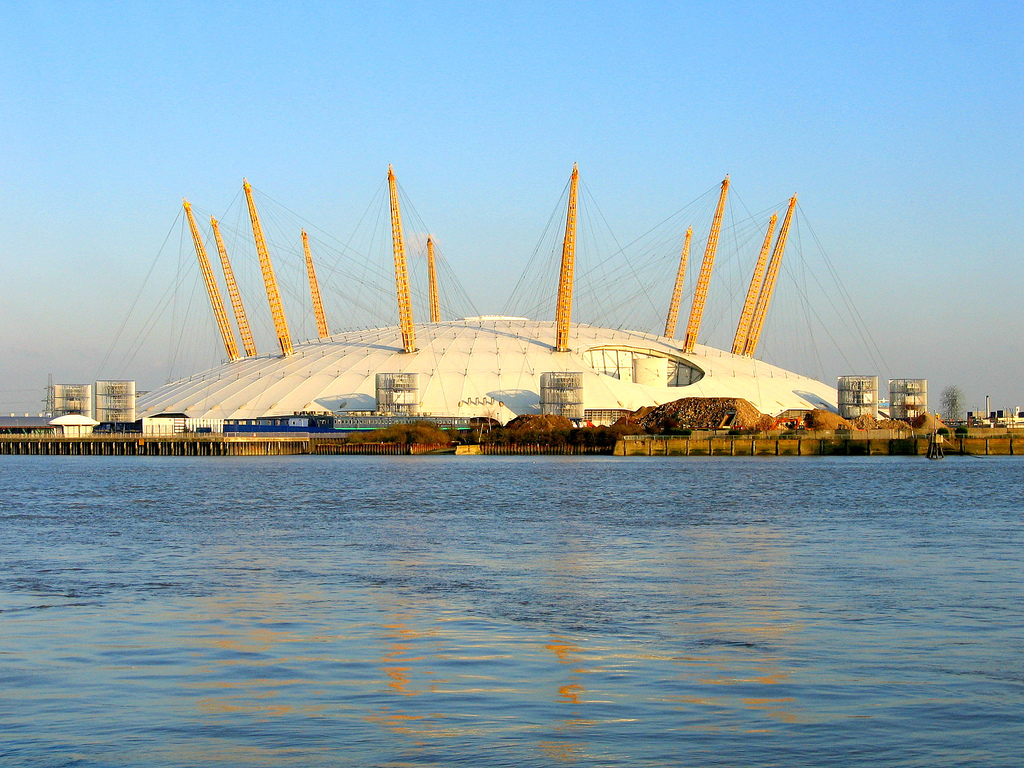
Millennium Dome
The Millennium Dome was the original name of the large dome-shaped building on the Greenwich Peninsula in South East London, England, which housed a major exhibition celebrating the beginning of the third millennium. As of 2022, it is the ninth largest building in the world by usable volume. The exhibition was open to the public from 1 January to 31 December 2000. The project and exhibition were highly contentious and attracted barely half of the 12 million customers its sponsors forecasted, and so were deemed a failure by the press.[2] All the original exhibition elements were sold or dismantled.
This article is about the Dome's use as a Millennium exhibition. For its post-redevelopment use, see The O2.Millennium Dome
Exhibition space
Dome
Converted into The O2 Arena
1999
31 December 1999
31 December 2000
Steel, tensioned fabric
BuroHappold Engineering
In a 2005 report, the cost of the Dome and surrounding land (which increased to 170 acres from the initial offering of the 48 acres enclosed by the Dome) and managing the Dome until the deal was closed was £28.7 million. The value of the 48 acres occupied by the Dome was estimated at £48 million, which could have been realised by demolishing the structure, but it was considered preferable to preserve the Dome. The structure itself still exists and is now a key exterior feature of The O2.
The Prime Meridian passes the western edge of the Dome and the nearest London Underground station is North Greenwich on the Jubilee line.
Background to the Dome project[edit]
The Dome project was conceived, originally on a somewhat smaller scale, under John Major's Conservative government, as a Festival of Britain or World's Fair-type showcase to celebrate the third millennium. The incoming Labour government elected in 1997 under Tony Blair greatly expanded the size, scope and funding of the project, and construction began in June 1997.[14] It also significantly increased expectations of what would be delivered. Just before its opening Blair claimed the Dome would be "a triumph of confidence over cynicism, boldness over blandness, excellence over mediocrity".[15] In the words of BBC correspondent Robert Orchard, "the Dome was to be highlighted as a glittering New Labour achievement in the next election manifesto", but criticised in the 2001 Conservative Party manifesto as "banal, anonymous and rootless", and lacking "a sense of Britain's history or culture".[16] Following the death of Diana, Princess of Wales, a member of the Dome's board suggested the project be refashioned and extended "to accommodate, for example, a hospital, businesses, charities, private residences, and the whole thing named 'the Princess Diana Centre'". The idea was later scrapped.[17]
Before its opening, the Dome was excoriated in Iain Sinclair's diatribe, Sorry Meniscus – Excursions to the Millennium Dome (Profile Books: London 1999, ISBN 1-86197-179-6), which forecast the hype, the associated political posturing, and the eventual disillusion. The post-exhibition plan had been to convert the Dome into a European football stadium which would last for 25 years: Charlton Athletic at one point considered a possible move but instead chose to redevelop their own stadium. Local team Fisher Athletic were at one time interested in moving to the Dome, but they were considered to have too small a fan base to make this feasible. The Dome was planned to take over the functions performed by the London Arena after its closure. This is the function which The O2 Arena has now undertaken.